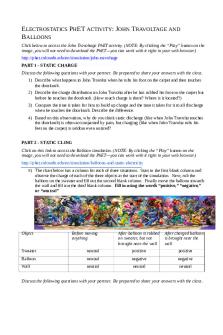2.2Electrostatics Ph ETCP v PDF

| Title | 2.2Electrostatics Ph ETCP v |
|---|---|
| Author | Hannah Lexer |
| Course | Physics |
| Institution | High School - USA |
| Pages | 2 |
| File Size | 146.1 KB |
| File Type | |
| Total Downloads | 18 |
| Total Views | 171 |
Summary
This was a phet I completed in class....
Description
ELECTROSTATICS PHET ACTIVITY: JOHN TRAVOLTAGE AND BALLOONS Click below to access the John Travoltage PhET activity. (NOTE: By clicking the “Play” button on the image, you will not need to download the PhET—you can work with it right in your web browser.) http://phet.colorado.edu/en/simulation/john-travoltage PART 1 - STATIC CHARGE Discuss the following questions with your partner. Be prepared to share your answers with the class. 1) Describe what happens to John Travolta when he rubs his foot on the carpet and then touches the doorknob. 2) Describe the charge distribution on John Travolta after he has rubbed his foot on the carpet but before he touches the doorknob. (How much charge is there? Where is it located?) 3) Compare the time it takes for him to build up charge and the time it takes for it to all discharge when he touches the doorknob. Describe the difference. 4) Based on this observation, why do you think static discharge (like when John Travolta touches the doorknob) is often accompanied by pain, but charging (like when John Travolta rubs his feet on the carpet) is seldom even noticed? PART 2 - STATIC CLING Click on this link to access the Balloon simulation. (NOTE: By clicking the “Play” button on the image, you will not need to download the PhET—you can work with it right in your web browser.) http://phet.colorado.edu/en/simulation/balloons-and-static-electricity 5) The chart below has a column for each of three situations. Start in the first blank column and observe the charge of each of the three objects at the start of the simulation. Next, rub the balloon on the sweater and fill out the second blank column. Finally move the balloon towards the wall and fill out the third blank column. Fill in using the words “positive,” “negative,” or “neutral”
Object
Before moving anything
After balloon is rubbed on sweater, but not brought near the wall
After charged balloon is brought near the wall
Sweater
neutral
positive
positive
Balloon
neutral
negative
negative
Wall
neutral
neutral
neutral
Discuss the following questions with your partner. Be prepared to share your answers with the class.
6) In the simulation, did both the positive and negative charges move between objects? What did you observe and why? 7) What caused the balloon to gain electrons?
8) An object is polarized when it is still neutral, but the positive and negative charges have moved to opposite sides of the object. Did this happen to any of the objects in this simulation? Which object, and when?...
Similar Free PDFs

2.2Electrostatics Ph ETCP v
- 2 Pages

Formulari ph - formule ph
- 2 Pages

ph aktual dan ph potensial.docx
- 1 Pages

Importanta PH
- 2 Pages

PH 예비보고서 - PH 실험시 필요한 예비 보고서
- 12 Pages

Procedimiento PH
- 2 Pages

Ph e poh - Ph e poh
- 13 Pages

pH tanah (reaksi tanah)
- 1 Pages

MAKALAH MENENTUKAN PH
- 7 Pages

Informe sobre ph
- 18 Pages

Lab Assignment #2: pH
- 12 Pages

Bioquimica del pH
- 3 Pages

Laboratorio Bioquimica PH
- 4 Pages
Popular Institutions
- Tinajero National High School - Annex
- Politeknik Caltex Riau
- Yokohama City University
- SGT University
- University of Al-Qadisiyah
- Divine Word College of Vigan
- Techniek College Rotterdam
- Universidade de Santiago
- Universiti Teknologi MARA Cawangan Johor Kampus Pasir Gudang
- Poltekkes Kemenkes Yogyakarta
- Baguio City National High School
- Colegio san marcos
- preparatoria uno
- Centro de Bachillerato Tecnológico Industrial y de Servicios No. 107
- Dalian Maritime University
- Quang Trung Secondary School
- Colegio Tecnológico en Informática
- Corporación Regional de Educación Superior
- Grupo CEDVA
- Dar Al Uloom University
- Centro de Estudios Preuniversitarios de la Universidad Nacional de Ingeniería
- 上智大学
- Aakash International School, Nuna Majara
- San Felipe Neri Catholic School
- Kang Chiao International School - New Taipei City
- Misamis Occidental National High School
- Institución Educativa Escuela Normal Juan Ladrilleros
- Kolehiyo ng Pantukan
- Batanes State College
- Instituto Continental
- Sekolah Menengah Kejuruan Kesehatan Kaltara (Tarakan)
- Colegio de La Inmaculada Concepcion - Cebu


